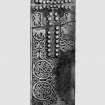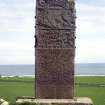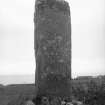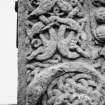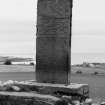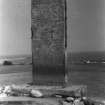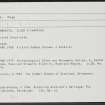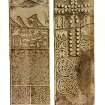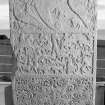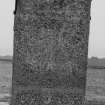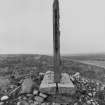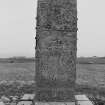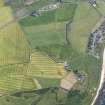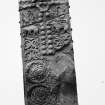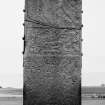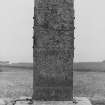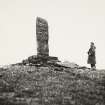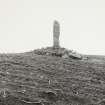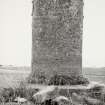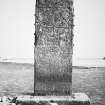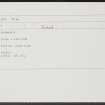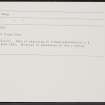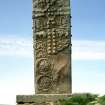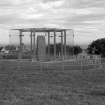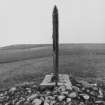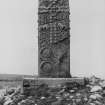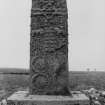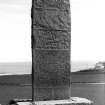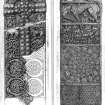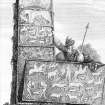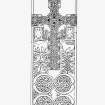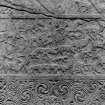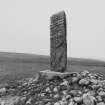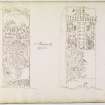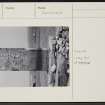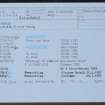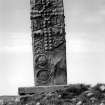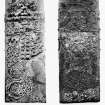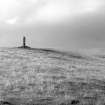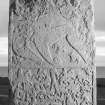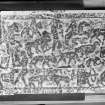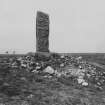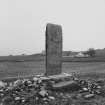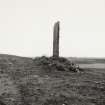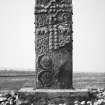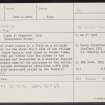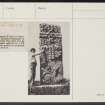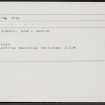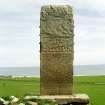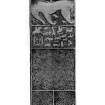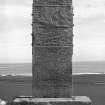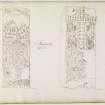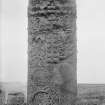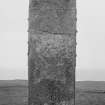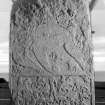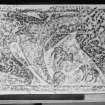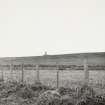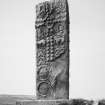Shandwick Stone
Cross Slab (Pictish), Pictish Symbol Stone (Pictish)
Site Name Shandwick Stone
Classification Cross Slab (Pictish), Pictish Symbol Stone (Pictish)
Alternative Name(s) Clach A' Charridh
Canmore ID 15278
Site Number NH87SE 4
NGR NH 85544 74718
Datum OSGB36 - NGR
Permalink http://canmore.org.uk/site/15278
- Council Highland
- Parish Nigg (Ross And Cromarty)
- Former Region Highland
- Former District Ross And Cromarty
- Former County Ross And Cromarty
Shandwick, Ross and Cromarty, Pictish cross-slab fragments
Measurements: H 2.70m +, W 0.99m, D 0.21m
Stone type: pale sandstone
Place of discovery: NH 8555 7471
Present location: in situ in field near Shandwick village.
Evidence for discovery: first recorded by Cordiner in 1776, when it stood intact on the edge of a terrace. After it was blown down, breaking into three pieces, around 1846, two fragments were clamped together (the third basal part was presumably still below ground) and set upright in a rectangular slot in a large stone slab. In 1988 the stone was removed and conserved, prior to being re-erected in a large glass pavilion, and the immediate area was excavated, without finding the original base of the stone. Nearby there was a burial ground last used in 1832.
Present condition: very badly weathered at the top and the lower right-hand part of face A. The very top of the slab is missing as is the base, and what survives of the base is trimmed at either side.
Description
This is a very substantial slab carved in relief on both broad faces but not on the narrow faces. It is rectangular but the side-arms of the cross on face A project slightly (15mm) to interrupt the vertical line of the sides, and the original top was raised above the upper arm of the cross. Faces A and C are bordered by plain flatband mouldings and face C is divided into panels by flatband mouldings. Face A is treated as one large panel of intricate ornament. The upper part of face A is dominated by a raised cross with rectangular terminals to the arms and wide shallow armpits with a central cusp. The cross is filled with double linked rows of raised spiral bosses, with four bosses creating a cruciform shape at the centre of the head. Flanking the upper arm on the left is a quadruped with an elongated neck turning back with ears sprouting interlace knots, and a foreleg extending into interlace beneath its belly. The area to the right of the upper arm is defaced. Beneath the side-arms are winged angels each placed within a frame of cable moulding, and figure-of-eight knots to fill the space between the angel vignettes and the top of the cross-shaft. Below the angel on the left is a boar facing left and trampling a small human figure, below which is a quadruple knot of zoomorphic interlace. On the right of the shaft, below the angel, is a lion above a knot of four serpents with fishtails. Below the base of the cross there was originally an intricate design consisting of four animal-headed serpentine creatures forming four circles filled and surrounded by dense interlace emanating from their own bodies, but much of the right-hand area of this ornament is defaced. At the foot of the slab as it survives are parts of two unenclosed panels of key pattern, both diagonal and spiraliform.
Face C is divided into eight distinct panels separated by flatband mouldings. The top panel is much weathered but clearly contains a double disc symbol filled with spirals. The next panel contains a Pictish beast symbol facing left, all its extremities ending in spirals and its lappit formed of T-bar fret. Three dwarf quadrupeds frolic beneath its head and body. The third panel is busy with naturalistic snapshots, each with a story for the viewer: a hunting scene runs along the top with horsemen, hounds and deer, and a large central hunter on foot, below are other forest animals including a boar, while at bottom right is a crouching archer aiming for an apprehensive stag. In the opposite corner are two large confronted warriors armed with shields and swords, and in the centre a pair of bulls head to head.
The fourth and largest panel displays a glorious roundel of swirling spirals with hidden cruciform shapes amongst them. Below this there are two square panels, the left with two pairs of encircled interlace knots and the right filled with diagonal key pattern. They are partially obscured by the base in which the slab is set, and totally hidden below them are two more panels, this time rectangular. The left panel contains four intertwined serpentine creatures, and the right has another four arranged in a different and more complex interlace, and all the serpents have median-incised bodies.
Date: ninth century.
References: Cordiner 1780, 65; ECMS pt 3, 68-73; Henderson & Henderson 2004, 44-8, 77; Fraser 2008, no 128.
Desk-based information compiled by A Ritchie 2017.
NH87SE 4 8555 7471
(NH 8555 7471) Clach A' Charridh (NR) (Sculptured Stone)
OS 6" map, Ross-shire, 2nd ed., (1907).
This symbol stone stands in a field on a hillside sloping towards the sea above the S side of the village of Shandwick, where burials took place in former times. Blown down c.1846 and broken into two pieces it has since been repaired and re-erected on a circular stepped base which conceals some of the sculpture at the bottom.
It is an upright rectangular cross-slab c. 9ft high by 3ft 3ins with sculptured relief on two faces.
J R Allen and J Anderson 1903.
As described.
Visited by OS (I S S) 29 August 1972.
This symbol stone now lies within a steel framed glass case which is surrounded by a fence. The structure is to protect the stone from further erosion.
Visited by RCAHMS (DE), January 1997.
Class II symbol stone showing a cross on the east face. On the reverse is seen a double-disc in a panel above an elephant, which is itself over a panel showing fighting swordsmen and a crossbowman.
A Mack 1997.
Note (1979)
Shandwick, Cross-slab and Burial-ground+ NH 855 747 NH87SE 3 & 4
This well-preserved cross-slab, known as the Clach a' Carridh, is of Early Christian date; it measures 3m in height, 1 m in width and 0.34m in thickness. An associated burial-ground is reported to have been levelled about 1885.
RCAHMS 1979
(Stat Acct, xiii, 1794, 19; Allen and Anderson 1903, iii, 68-73; Macdonald and Laing 1970, 137)
Publication Account (1995)
This great cross-slab, known as the Clach a' Charridh, is one of the most impressive of all Pictish monuments. It stands in its original position on a hill overlooking the little fishing village of Shandwick, and is a landmark which can be seen from far out to sea. The stone blew down in 1846 and broke in half, but it has been carefully restored. It is now covered by a glass conservatory to protect it from pollution, necessary but unsightly.
The stone stands 2.7m high. On the face which looks out to sea is a prominent cross formed of protruding bosses, which are covered with a complex relief pattern of interlocking spirals. Below each arm is a small angel with two pairs of wings, then a beast each side of the stem, and then two contrasting groups of interlaced creatures, animals with ribbon-like bodies on the left and snakes on the right. Below the cross is a damaged pattern of large low bosses surrounded by snakes' bodies meeting head to gead, and covered with a mesh of interlace.
The other side of the stone is divided into five panels and decorated in rather lower relief. At the top is a damaged double-disc symbol with spiral patterns on it, and below this a 'Pictish beast' symbol, its body left quite plain, but tiny animals squeezed in below. The next panel has a positive menagerie of people and animals, including men on horseback, a man with a drinking horn, a stag being hunted, two men with swords and small shields fighting, and a kneeling man shooting a crossbow at a stag. The fourth panel has a most beautiful circular composition of interlocking spirals. The fifth panel carried four patterns, but parts of only two can now be seen.
Long after the Pictish origin of the cross-slabs had been forgotten, a local; legend grew up around this stone and its neighbours at Nigg and Hilton. In brief, the story is that the stones were erected to mark the graves of three Norse princes who were wrecked on a reef off Shandwick Bay while pursuing the Earl of Ross, because the Earl had illtreated his wife, their sister, and banished her to Ballone Castle. The reef is called the King's Sons or the Three Kings.
Close to the stone is an ancient graveyard, now under the plough, used in recent centuries only for the burial of unbaptised children, and in 1832 for cholera victims.
Information from ‘Exploring Scotland’s Heritage: The Highlands’, (1995).
Earth Resistance Survey (11 September 2013 - 13 September 2013)
NH 8555 7471 and NH 8556 7473 A resistance survey was undertaken, 11–13 September 2013, in the field around the Shandwick stone – a Pictish cross slab dating to the 7th or 8th century AD. The survey aimed to contextualise the landscape location of the stone as part of the Northern Picts: Archaeology of Fortriu project. The survey was focused on the area to the S and E of the Shandwick stone (an area to the NW has previously been surveyed by the University of York). A total of nine 20 x 20m grids were surveyed using a TR/CIA resistance meter. The area was walked in 1m transect lines and measurements were taken every 0.5m.
The survey recorded a number of anomalies, including regular rows of small sub-rectangular anomalies to the E and S of the stone. The anomalies to the E may relate to a known burial ground, which was used until the 1830s before being ploughed out in the 1880s by the tenant farmer (NH87SE 3). The anomalies to the S of the stone included suggestions of stone-built structures and further grave-like anomalies. One of these was sampled and human remains were identified under the ploughsoil. Dating of a loose fragment of bone has identified the burial as being of 18th-century date (SUERC-49032 182±30), indicating that the area around the Shandwick stone has been extensively used for burial in recent centuries.
Archive: University of Aberdeen
Funder: University of Aberdeen, Development Trust, University of Aberdeen and Tarbat Discovery Centre
Gordon Noble and Oskar G Sveinbjarnarson, University of Aberdeen, 2013
(Source: DES)


































































